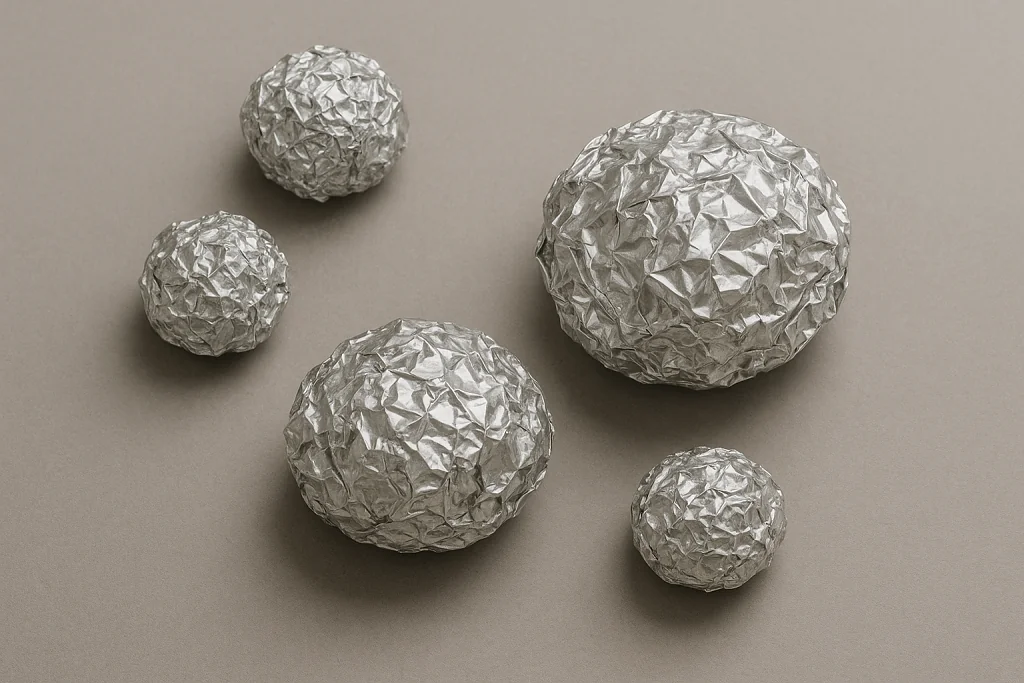Aluminum foil is a material present in homes and businesses, but its correct management still raises doubts. Many people discard it improperly, missing the opportunity to save energy and resources. This guide offers clear information on how to recycle aluminum foil and other wastes, facilitating their correct separation and reducing environmental impact.
Environmental Impact of Aluminum Foil and Recycling Challenges
How excessive use of aluminum foil contributes to environmental deterioration
Recycling aluminum foil is key to curtailing the environmental impact caused by the overuse of this material. Producing aluminum foil requires a high amount of energy. The extraction of bauxite, the raw material for producing aluminum, results in significant environmental degradation: deforestation, loss of biodiversity, and mass waste generation. Moreover, the process emits greenhouse gases and generates chemical waste that contaminates water and soils. Indiscriminate use of aluminum foil, especially in single-use packaging, multiplies this harmful effect and increases pressure on natural resources.
Common challenges in recycling aluminum foil and its impact on the environment
Although aluminum is 100% recyclable and can be re-used in new applications without losing its quality, there are significant barriers. One of the main challenges in recycling aluminum foil is its incorrect disposal: many people throw it in the wrong bin or with food residues, complicating its processing in recycling plants. Contamination with organic waste or oils prevents efficient recovery of aluminum, causing it to end up in landfills. This mistake increases the need to produce new aluminum, doubling the energy consumption compared to recycling and expanding the carbon footprint of the material’s lifecycle.
Myths and realities about the sustainability of aluminum
Aluminum enjoys a reputation as a sustainable material, as it can be endlessly recycled and retains 95% of its initial energy in each cycle. However, this sustainability depends entirely on its proper management. A common myth is that any aluminum foil gets recycled if it is deposited in the yellow bin, even if it is dirty or mixed with other materials. The reality is that only clean aluminum, free of food remnants and greases, is processed correctly. Therefore, effective aluminum foil recycling occurs only when the waste is well-separated and prepared. Recycling aluminum prevents tons of emissions and reduces the extraction of raw materials, but it requires civic responsibility in waste separation and cleaning.
List Summary:
- Environmental Impact: High energy demand, soil and air contamination.
- Difficulties: Contamination by food residues, errors in separation.
- Sustainable Reality: Only correct recycling harnesses the ecological benefits of aluminum.
Adopting a responsible attitude is crucial for aluminum foil recycling to provide real environmental and energy benefits.
Difficulties in Recycling Aluminum Foil
Frequent Errors: Incorrect Placement of Aluminum in Containers
One of the main obstacles to recycling aluminum foil is its disposal in the wrong container. Many people throw it in the general waste bin, thinking it is not recyclable or due to ignorance of its treatment. Recyclable aluminum foil should always be deposited in the yellow bin, along with other plastic, metallic, and brick containers. If mixed with organic waste or paper, it will not reach the correct plants and will not be recycled.
Most Common Errors:
- Throwing aluminum foil in the blue bin (paper/cardboard)
- Depositing it in the gray or general waste bin
- Mixing it with organic waste thinking it is not recyclable
Correct classification is essential to advance in aluminum recycling and prevent this material from ending up in landfills, losing its energy-saving potential.
Incorrect Preparation of Aluminum Foil and Its Consequences in Recycling
Effective recycling requires aluminum foil to arrive clean and compact. Failing to roll up the foil or remove product remnants inhibits its recovery at the plant. As lightweight sheets, aluminum can get lost during the automatic sorting phase if not compacted or grouped into balls. Loose fragments or those mixed with other containers can go unnoticed by magnetic systems, preventing their recycling.
To facilitate recovery:
- Remove food and grease remnants from the foil before discarding.
- Group used foils into a compact ball the size of a golf ball to prevent loss in the recycling chain.
If aluminum arrives dirty or poorly prepared, it’s discarded and treated as waste, increasing the environmental footprint.

Doubts About Recycling Aluminum Foil Contaminated With Food Residue
A common question is what to do when aluminum foil contains food residues, sauce, or oils. Severely contaminated foil is not recycled, as it blocks processing during smelting and introduces impurities. If it only has small stains, simply wiping the foil with a paper towel or lightly washing it before placing it in the yellow bin will suffice.
When to Recycle Aluminum Foil:
- Recycle: Dry, clean aluminum or with minimal residues.
- Do Not Recycle: Very greasy or sticky aluminum, totally soaked with organic residues (in this case, it goes in the general waste bin).
Clarifying these concepts ensures that the aluminum foil recycling process is efficient and sustainable, maximizing the recovery of this valuable material and reducing the environmental impact derived from incorrect practices.
Solutions and Effective Steps for Recycling Aluminum Foil
Practical Guide to Recycling Aluminum Foil Correctly
The first step in recycling aluminum foil is to always deposit it in the yellow bin, never in the blue or general waste bin. To ensure it gets recycled, follow this procedure:
- Remove Food Residues: If the foil has residues, clean it before discarding.
- Group into a Ball: Compact the used aluminum to prevent it from being lost in the sorting chain.
- Ensure It Isn’t Combined: Don’t mix it with other materials like plastic or paper to facilitate recycling.
These simple gestures ensure the aluminum foil reaches the recycling plant in optimal conditions.
Techniques to Identify and Correct Errors When Recycling Aluminum Foil
To avoid common errors:
- Check Labels: Not all silver-colored products are aluminum; if in doubt, consult recycling symbols.
- Consult Municipal Resources: Some municipalities provide online search tools to know where to dispose of each type of waste.
- Educate at Home and Work: Encourage everyone to correctly separate aluminum foil, remembering it always belongs in the yellow bin.
Correcting these errors increases recovery of this material and prevents its loss in the process.
Detailed Instructions on Collection and Smelting Process
- Selective Collection: Clean aluminum foil deposited in the yellow bin is taken to sorting plants.
- Classification: There, it is separated by type to isolate aluminum from other wastes.
- Compacting: The pieces are pressed into blocks or briquettes.
- Smelting: Aluminum enters furnaces, where it is melted at high temperatures.
- New Cycle: The recycled material is used to manufacture new products, recovering up to 95% of the original production energy.
The efficiency of this process depends on the quality of the deposited waste; therefore, cleaning and compacting are crucial.
Comparison with Recycling Methods of Other Materials
The recycling of aluminum foil differs from that of other wastes in both the purity required and energy savings:
- Cardboard: Its recycling is more forgiving of light residues but loses quality after several cycles.
- Plastic: The variety of polymers complicates recovery and requires more manual sorting.
- Aluminum: Supports unlimited recycling cycles without losing quality and offers the greatest energy savings compared to cardboard or plastic.
Recycling aluminum foil stands out for its contribution to resource savings, provided the waste is separated and prepared properly. This helps contribute to a more efficient and responsible consumption model.
Benefits and Advantages of Aluminum Foil Recycling
Economic Benefits from Reducing Virgin Aluminum Demand
Recycling aluminum foil means significant economic savings. Producing aluminum from recycled material consumes up to 95% less energy than manufacturing from virgin ore. This reduction in energy consumption implies lower costs for the industry and less pressure on the energy bill of waste management systems. Moreover, by relying less on the extraction of new raw materials, manufacturing processes become cheaper, and price volatility associated with bauxite is reduced. For households and businesses, promoting recycling facilitates the creation of circular economies, where waste becomes new, durable, and viable resources.
Positive Impact on Environmental Preservation and Resources
Recycling aluminum foil offers clear benefits for environmental protection:
- Conservation of Natural Resources: Recycling avoids massive extraction of bauxite, a non-renewable raw material, and protects ecosystems affected by mining.
- Reduction of Waste and Emissions: Fewer landfilled waste results in less soil and water contamination. Aluminum recycling also reduces CO₂ emissions and other greenhouse gases.
- Energy Conservation: By requiring less energy for processing, recycling minimizes the demand for fossil fuels and promotes more efficient energy management.
- Promotion of Circular Economy: Recycled aluminum can be reused as many times as necessary, driving sustainable production chains and avoiding premature resource depletion.
Recycling aluminum foil not only helps comply with environmental regulations but is also a straightforward and effective action to protect the planet and ensure a cleaner, healthier future for all.
Sustainable Alternatives to Aluminum Foil Use
Advantages of Using Cardboard Packaging Over Aluminum Foil
Cardboard is one of the most widespread alternatives to aluminum foil in packaging and containers. It shows clear advantages from an environmental and practical standpoint. Being renewable and sourced from sustainably managed forests, its ecological cost is much lower. Additionally, its selective collection and recycling process are more ingrained in society, contributing to higher recovery rates.
- Reduction in energy consumption compared to metallic materials
- Facilitates household and workplace separation
- Lower landfill impact as it degrades easily
Characteristics of Cardboard Packaging: Biodegradability and Cost Savings
One of the main strengths of cardboard is its biodegradability. It decomposes swiftly in natural environments, preventing long-term waste accumulation. This makes it the priority choice when seeking to minimize environmental impact. It also stands out for its economic efficiency:
- Low production and transportation costs due to its lightweight nature
- Lesser dependence on non-renewable resources
- Facilitates reuse and recycling into new products
Thanks to its versatility, it is perfect for creating suitable cardboard food packaging, consumer products, and parcels, catering to the market’s new sustainability demands.

